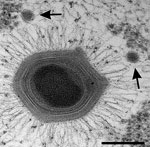Volume 26, Number 10—October 2020
Etymologia
Etymologia: Mimivirus
If virus (Latin: slimy) challenges the definition of what constitutes life, the DNA mimivirus tests how we define virus. This unidentifiable “bacterium” infecting Acanthamoeba polyphaga (Figure), was isolated in 1992 from a hospital cooling tower in Bradford, England. Thus, the original name was Bradfordcoccus, and it was considered a culprit for a pneumonia outbreak at this hospital.
Researchers brought samples to Didier Raoult and colleagues at Aix-Marseille University, who eventually identified this “bacterium” as a novel virus in 2003. The physical size, genomic content, and ability of the outer protein coat to stain gram positive, thus mimicking (Latin: imitate) prokaryotic bacteria, indicated that this pathogen might be a bacterium.
Raoult initially claimed that the moniker meant “mimicking microbe” but later sheepishly recounted a childhood memory about his father, a physician–scientist, who created stories to explain evolution. Featured prominently in these whimsical narratives was an anthropomorphic character named “Mimi the amoeba.”
References
- Redefining life [cited 2020 Jul 2]. https://www.rsb.org.uk/biologist-features/158-biologist/features/1490-larger-than-life
- Viruses reconsidered [cited 2020 Jul 20]. https://www.the-scientist.com/features/viruses-reconsidered-37867
Figure
Cite This ArticleOriginal Publication Date: September 09, 2020
Related Links
Table of Contents – Volume 26, Number 10—October 2020
| EID Search Options |
|---|
|
|
|
|
|
|

Please use the form below to submit correspondence to the authors or contact them at the following address:
Clyde Partin, Emory University School of Medicine, 1365 Clifton Rd NE, Clinic A, 1st Fl, Atlanta, GA 30322, USA
Top